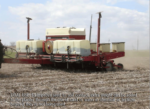Advertise Follow Us
Articles Tagged with ''No-till''
Make The Right Moves To Boost No-till Planter, Drill Performance
How growers handle down pressure, weight, attachment selection and more plays a large part in determining no-till success, says ag engineer Paul Jasa.
Read More
Eugene Keeton, Inventor of Seed Firmer, Passes Away
Keeton’s insightful approach to handling farmer challenges helped him build several planter inventions that led to better crop stands and yields for no-tillers.
Read More







